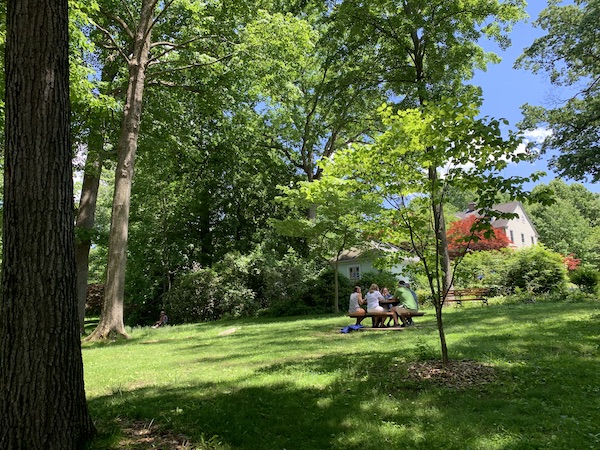Getting on Track with Breast Health
- Details
- Written by Joanne Wallenstein
- Category: Health
 The following was written by Dianne Seo, DO, Breast Surgery at White Plains
The following was written by Dianne Seo, DO, Breast Surgery at White Plains
It is never too early to take steps to decrease your risk for developing breast cancer. The American Cancer Society (ACS) predicts about 311,000 new cases and 42,000 deaths. Breast cancer is second only to lung cancer for cancer-related deaths in women.
I encourage you to ask your healthcare provider about which screening tests are right for you if you are at higher risk. If you are at average risk, start annual mammograms at age 40 and clinical breast exams at age 20. Mammography is a low-dose X-ray that can detect breast cancer before it can be felt. Early detection saves lives by reducing the risk of death from breast cancer and increasing treatment options.
The first step is to know your risk and discuss it with your healthcare provider: do you have any family history of breast and/or ovarian cancers or inherited genetic mutations in breast cancer-susceptible genes? What is your reproductive and menstrual history? Also address potentially modifiable risk factors associated with breast cancer.
Women who exercise regularly have a 10-20% lower risk of developing breast cancer than those who do not. The ACS recommends 2.5-5 hours of moderate physical activity, or 1-2 hours of vigorous activity, a week. This can look different for all of us; it can include walking for 30-45 minutes every day, taking the stairs, dancing, running, weightlifting, doing yoga, Pilates or swimming a couple of times a week.
Studies have also shown that women who have three or more alcoholic drinks in a week have a 15-20% increased risk when compared to those who do not drink. Try to limit your alcohol intake to 1-2 drinks a week or consider non-alcoholic alternatives.
If you are undergoing any menopausal hormone therapy/combination hormone replacement therapy, talk to your provider about limiting or stopping them, as well as about potential alternative options. Women who use estrogen plus progestin have an increased risk of an abnormal mammogram within the first year of taking menopausal hormone therapy, and significantly increased risk of breast cancer with 5 or more years of use.
And keep in mind that breastfeeding actually decreases the risk of breast cancer.
In summary:
· Know your risk
· Maintain a healthy weight with regular exercise and eating a whole-food diet
· No smoking!
· Limit alcoholic beverages to 1-2 drinks a week
· Limit menopausal hormonal therapy (combination hormone replacement therapy)
· Schedule screening mammograms and clinical breast exams More information about breast imaging can be found here.
More information about breast imaging can be found here.
Dr. Dianne Seo is a breast surgeon at the White Plains Hospital Center for Cancer Care. To make an appointment, call 914-849-7580.
Health Matters: The original version of this article was published in Health Matters, a White Plains Hospital publication.
Advancing Stroke Care in Our Community
- Details
- Written by Joanne Wallenstein
- Category: Health
 Having brainpower in stroke patients demands medical insight and quick thinking. At White Plains Hospital, the standard of care includes the most advanced technology and services.
Having brainpower in stroke patients demands medical insight and quick thinking. At White Plains Hospital, the standard of care includes the most advanced technology and services.
Each year, approximately 795,000 people in the U.S. suffer strokes — 17% of which are fatal. With one of the most compre¬hensive stroke programs in the region, providing immediate and lifesaving stroke care is an area where White Plains Hospital and its newly appointed Director of Stroke Services, Dr. Paul Lleva, is proud to excel.
Board-certified in neurology, vascular neurology, neurosonology (or brain imaging), and internal medicine, Dr. Lleva currently sees patients at White Plains Hospital Physician Associates in Somers and is working to further enhance the Hospital’s robust stroke care program. “White Plains Hospital has been building a world-class stroke program, bringing in top specialists and the latest technology and treatments,” Dr. Lleva says. “As we look to the future, our program aims to be the top advanced stroke care provider in our region and beyond.”
Recent notable advances in stroke care at the Hospital include:
QUICKER CLOT BUSTERS. “For every minute elapsed after a stroke, a patient may lose 1.9 million neurons,” or nerve cells in the brain, says Dr. Lleva. The team at White Plains Hospital relies on the newest medicine, called Tenecteplase, to rapidly dissolve the clots obstructing blood flow. “This drug works very specifically against the clot, destroying it more quickly and more effectively than previous medications,” he says.
THE GOLD STANDARD OF CARE. The highest-quality acute care currently available for strokes, a procedure called a mechanical thrombectomy, is currently being performed at White Plains Hospital. During this minimally invasive procedure, specially designed instruments are inserted into a large blood vessel in the groin through a small port and threaded through thin catheters to reach — and remove — blood clots in the brain within 24 hours from symptom onset.
To assist in these procedures, the Stroke Team at the Hospital also uses advanced imaging, called perfusion imaging, to differentiate salvageable brain tissue from irreversibly damaged brain tissue to pinpoint cases where mechanical thrombectomies will be most effective.
ARTIFICIAL INTELLIGENCE (AI)-POWERED SOFTWARE. This modern technology guides radiologists and neurologists toward the correct intervention within seconds. “Our team uses software that will detect the amount and location of salvageable brain tissue, as well as damaged tissue,” Dr. Lleva says. “As a tool for our care team, it provides a more uniform and consistent diagnosis in rapid time.”
24/7 EMERGENCY CONSULTATIONS. At White Plains Hospital, a neurologist is always available for an emergency consultation at the bedside, either in-person or remotely. “With tele-stroke services, a vascular neurologist can expeditiously see the patients within minutes of arrival, allowing us to quickly diagnose patients and get them appropriate care immediately,” Dr. Lleva says.
WORLD-CLASS TEAM. The increasing complexity of stroke cases seen at White Plains Hospital has driven the recruitment of experts in neurocritical care and neuroendovascular surgery with decades of experience in treating and managing advanced stroke cases.
SMOOTHER RECOVERY. After stroke, some patients will develop arm and leg spasticity, language difficulty, pain, inability to walk, and limited ability to care for themselves. These complications are addressed in our outpatient stroke center in collaboration with Burke Rehabilitation to improve patients’ mobility, lessen discomfort, and restore quality of life.
To make an appointment with Dr. Lleva at 325 Route 100, Somers, NY, call 914-849-5300.
Healthy Teeth, Healthy Heart: The Link Between Dental Health and Heart Disease
- Details
- Written by Joanne Wallenstein
- Category: Health
 If you are taking care of your dental health, you could be doing more than just guaranteeing a great smile — you could also be protecting your heart. Research points to a likely connection between periodontal disease (commonly known as gum disease) and heart disease, says Dr. Joseph Leanza, Director of the new White Plains Hospital Dental Care, which opened in December 2023.
If you are taking care of your dental health, you could be doing more than just guaranteeing a great smile — you could also be protecting your heart. Research points to a likely connection between periodontal disease (commonly known as gum disease) and heart disease, says Dr. Joseph Leanza, Director of the new White Plains Hospital Dental Care, which opened in December 2023.
About 47 percent of people older than 30 are impacted by gum disease, which is characterized by a bacterial infection, according to the CDC. As Dr. Leanza explains, these bacteria can move through your bloodstream, generating inflamma¬tion in your blood vessels — particularly in your coronary arteries. The inflamma¬tion can make it easier for cholesterol and fats (also known as plaque) to stick to the insides of your arteries, which in turn could increase your risk for heart disease as well as a heart attack.
“Periodontal and cardiovascular disease have many risk factors in com¬mon, such as smoking, poor diet, and hypertension,” says Dr. Joshua Latzman, Cardiologist at White Plains Hospital Physician Associates. Modifying these risk factors, he states, is crucial for optimal oral and heart health.
There are also multiple ways to help re¬duce your risk of gum disease — and fight it if you’re already showing symptoms, such as gums bleeding when you brush or prolonged bad breath, says Dr. Leanza. The dental expert has been affiliated with White Plains Hospital for more than 25 years and is now practicing in a brand-new, state-of-the-art facility at 79 East Post Road in White Plains.
“The first step is to go to the dentist regularly for evaluation,” he says, adding that twice-a-year cleanings are recommended; in some cases, going three or four times a year, or seeing a specialist like a periodontist, may be necessary. Your dentist may also suggest advanced treatments like scaling — a more intense cleaning — which can help fight gum disease. In addition to routine exams and cleanings, White Plains Hospital Dental Care offers the full complement of dental services, including oral cancer screenings, X-rays, crowns and bridges, dentures, extractions, fillings, implants, and root canals.
Dr. Latzman also emphasizes that patients who have undergone heart valve surgery should take extra precaution prior to a dental visit. “The bacteria that is introduced from the mouth into the blood¬stream during dental procedures can place those with prosthetic heart valves at risk for a condition known as endocarditis, so speak with your physician about whether you should take an antibiotic prior to a dentist visit,” he says.
Proper at-home care, including brushing and flossing, is equally as important. Dr. Leanza notes that your dental hygienist can recommend specific products, like a water flosser, or even certain toothpastes or oral rinses that can help specifically with gum disease.
“Prevention is always the best way to approach health issues,” says Dr. Leanza. “The earlier we start, the better, but it’s nev¬er too late to improve your dental health.”
To make an appointment at White Plains Hospital Dental Care, call 914-849-3488.
Forum Committee Urges Stronger Measures to Save Scarsdale's Shrinking Tree Canopy
- Details
- Written by Joanne Wallenstein
- Category: Health
 Chase Park: Photo by Cynthia RobertsA committee of the Scarsdale Forum is calling for far-reaching changes to Village code regarding trees after a report revealed extensive losses to Scarsdale’s tree canopy. Committee Chair Madelaine Eppenstein, who is one of the authors of the report said, “the report cites six years of permit data compiled by the Village indicating significant tree loss — of almost 1,000 trees removed with permits annually — without adequate replacement planting to maintain Scarsdale’s tree canopy. This data does not reflect trees that are removed illegally, or legally under certain circumstances”
Chase Park: Photo by Cynthia RobertsA committee of the Scarsdale Forum is calling for far-reaching changes to Village code regarding trees after a report revealed extensive losses to Scarsdale’s tree canopy. Committee Chair Madelaine Eppenstein, who is one of the authors of the report said, “the report cites six years of permit data compiled by the Village indicating significant tree loss — of almost 1,000 trees removed with permits annually — without adequate replacement planting to maintain Scarsdale’s tree canopy. This data does not reflect trees that are removed illegally, or legally under certain circumstances”
And why is it so important to maintain the tree canopy? The Village’s tree code clearly outlines why trees are essential.
It says, ““The Village of Scarsdale finds that trees within the Village provide an important contribution to the health, safety, aesthetics and general welfare of Scarsdale residents and the community at large. Trees provide shade and aesthetic appeal, enhance green space, improve air quality, reduce energy use and atmospheric carbon dioxide, provide and promote habitat for wildlife, impede soil erosion, aid water absorption, inhibit excess runoff and flooding, provide screening, offer a natural barrier to noise, provide other environmental benefits and generally enhance the quality of life within the Village. These social, economic, and ecological benefits often increase as trees mature and the Village community's investment in trees has accrued over many years. This investment can be rapidly lost and is not easily nor quickly replaced due to the long length of time for a tree to mature. The destruction of and damage to trees and the indiscriminate and excessive cutting of trees can create barren and unsightly conditions, as well as surface drainage problems, increase municipal costs to control drainage, impair the value of real property and adversely affect the environment, health and character of the community.”
In order to protect existing trees the report calls for the Village to change the tree code to preserve the canopy by limiting which types of trees can be removed, requiring more tree replacements than currently called for and stepping up enforcement and fines for illegal tree removals.
The report goes further by requiring permits for the removal of dead or dying trees or invasive species. About these trees the report says invasives, “are still part of our canopy, providing water absorption, shade, and animal habitat. Due to the change in how residents maintain their properties and the decreasing amount of green space in our neighborhoods, invasive trees cannot spread as freely as they did in the past. These trees should be treated like any other tree that requires a removal permit and replacement.”
In light of the current building moratorium the committee is asking the trustees to examine the tree code at the same time they are analyzing the Village’s building and land use codes, as they are intrinsically tied together.
At the conclusion of the report drafted by the Sustainability and Municipal Services Committees On Environmental Protection and Preservation of Trees in the Village of Scarsdale, they make the following recommendations to the Scarsdale Board of Trustees:
1. Village formation, as directed by the Mayor and Board of Trustees, of a committee comprised of Village staff and representatives of the Scarsdale Forum, Friends of the Scarsdale Parks, and the Conservation Advisory Council, to review and implement the recommendations set forth in this Report;
2. Amend the Village Code as recommended in this Report;
3. Enforce the Village Code and amendments as recommended in this Report;
4. Revise Village staff and land use board procedures as set forth in this Report;
5. Appoint a voting member focused on environmental issues to the Board of Architectural Review. See also Scarsdale Inquirer, Letter to the Editor (Jan. 14, 2024, l
6. Institute a public education campaign and enlist the cooperation and support of the public consistent with these recommendations.
The report concludes with the following:
The six-year spreadsheet compiled by the Village regarding tree removal regulation reveals an ongoing practice of permitting the removal of trees without requiring replacements in kind, among other affirmative measures that could and should be taken to protect and preserve trees and our tree canopy. This history must be reversed before Scarsdale, our beloved village in a park, is reduced to an overbuilt and unremarkable suburb.
The report quotes world-renowned entomologist and wildlife ecologist Professor Douglas W. Tallamy who says,“We do not have the right to heat up our neighbor’s airspace by cutting down the trees on our property. . . . In short, we no longer have the right to ignore the stewardship responsibilities attached to land ownership. Our privately owned land and the ecosystems upon it are essential to everyone’s well-being, not just our own. Abusing land anywhere has negative ramifications for people everywhere."
In enacting Local Law No. 1 of 2024, the Board of Trustees has acknowledged the urgent need to reexamine Village Code provisions and related rules and regulations – as well as the practices of the land use boards and Village staff – in order to protect the character and environment of our Village. How we continue to approach development forms the basis of what our Village will be and what we leave for future generations. The Committees respectfully submit that significant steps must be taken expeditiously to amend the Village Code, to enforce the Village Code, and to enhance land use processes in order to stem the damage to our environment.”
Sign Up for the 54th Annual Scarsdale 15K and 4M Runs
- Details
- Written by Joanne Wallenstein
- Category: Health
 The 54th Annual Scarsdale 15K & 4M Runs will take place on Sunday, April 7th. These are among the oldest road races in Westchester County and runners and walkers of all abilities are welcome! The races start and end at Scarsdale High School and route through the Fox Meadow and Greenacres neighborhoods. Visit here for course maps and registration.
The 54th Annual Scarsdale 15K & 4M Runs will take place on Sunday, April 7th. These are among the oldest road races in Westchester County and runners and walkers of all abilities are welcome! The races start and end at Scarsdale High School and route through the Fox Meadow and Greenacres neighborhoods. Visit here for course maps and registration.
Awards will be given to the top male and female finishers overall in both the 15K and 4M races, the top male and female Scarsdale finishers in the 15K race, and the top three male and female finishers in each age division for both races.
A virtual race option is available for those who would like to run the race on their own and have their finishing time displayed on the Results page of the website.
At around 8:30 am, the Scarsdale Police Department will restrict traffic through the Fox Meadow and Greenacres neighborhoods, though local access will be permitted.














